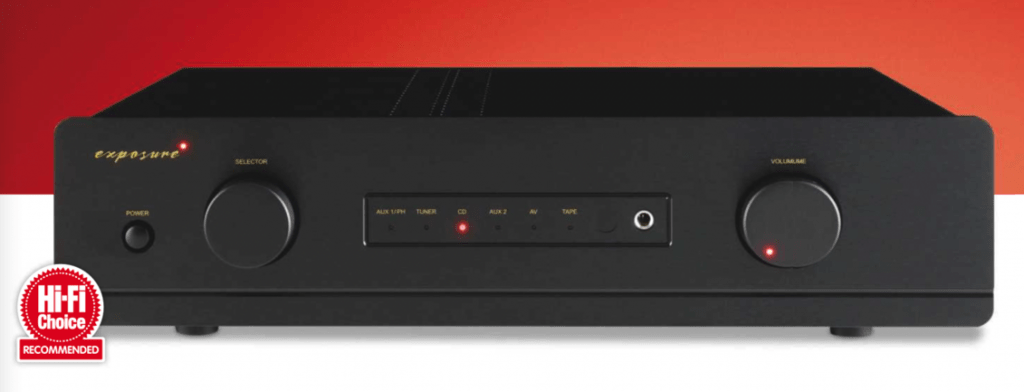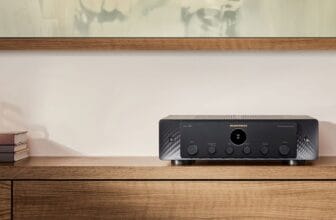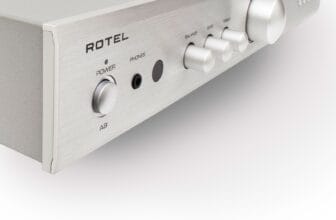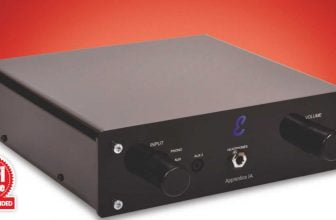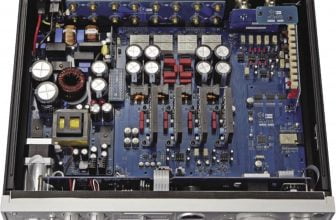Exposure 3510 Review: Back tracking to the future
Malaysian-owned, Brit-based company returns to its roots with a full-width integrated inspired by the improved circuit design of its recent 5010 monoblock power amps. Read our Exposure 3510 Review.
Nostalgia doesn’t come any better than this: an integrated amplifier that looks like it escaped from the Eighties, all minimalist and line-level and 440mm wide. But Exposure has been around for close to 50 years, so this isn’t just some exercise in retro from an arriviste brand with cod heritage. Rather, the 3510 is a device for reminding people of hi-fi life in simpler times.
ORIGIN UK
TYPE Integrated amplifier
WEIGHT 12kg
DIMENSIONS (WxHxD) 440 x 115 x 300mm
FEATURES
Quoted power output: 2x 110W (8ohm)
Inputs: 6x RCA line-level
Outputs 2x pre;
6.35mm headphone Optional MM,
MC or DAC board
DISTRIBUTOR Exposure Electronics Ltd.
WEBSITE exposurehifi.com
Even its realistic price of £ equates to around £ in 1980 money, typical of a quality British integrated amplifier of a politically correct nature in decades gone by.
It’s part of a new range – with all models available in a choice of black or titanium finishes and sharing the same casework – which will ultimately comprise the 3510 stereo power amplifier, 3510 mono power amplifier, 3510 preamplifier, and a selection of additional optional plug-in modules.
There are three forthcoming plug-ins – a USB/DSD64-compatible digital-to-analogue converter and a moving-magnet or moving-coil phono board, but the 3510 can only house one. Both phono modules will offer two sensitivity/gain settings combined with 47kohm loading for moving-magnet and 100, 110, 130, 160, 210, 310 and 470ohm for the moving-coil board. In the spirit of the price category, here we’ve opted to review our line-only 3510 without any of the boards.
Specs-wise, too, the 3510 integrated amplifier could have been plucked from the pages of the 1980 Hi-Fi Choice Yearbook although obviously key areas of the preamp circuit design – and even the choice of power transistors – have witnessed a process of evolution and improvement over the decades. Otherwise Exposure operates under the very sensible ‘if it ain’t broke, don’t fix it’ school of engineering. The conservative factory power rating is quoted as 110W into 8ohm loads and it provides line inputs labelled Aux/Phono, CD, Aux 2, AV with fixed gain for switchable home theatre bypass, a tape in/out loop and two preamp outs – the latter useful for feeding subwoofers or for connecting other power amplifiers.
All of these are single-ended RCA connections, accompanied by two sets of loudspeaker outputs for which Exposure has taken a bold step – instead of multi-way binding posts, the 3510 accepts banana plugs only. And, in case you’re wondering why an amplifier would offer two sets of speaker outputs, but no A/B speaker selector switch (as was once the fashion), their role here is merely to simplify bi-wiring.
Its uncluttered front panel contains, from left to right: a push button for power on/off, rotary source selector, a row of LEDs to indicate the chosen source, a sensor for the remote control and a 6.35mm headphone socket. The supplied remote control is a new system commander with buttons for other Exposure components, but here deals with the basics, ie: source, volume up/down and mute.
The installation is self-explanatory for anyone that has ever gone through the process of setting up a basic system, which adds to the delicious blast-from-the-past ambience. The lack of phono or DAC modules in our sample makes life even easier, and we immediately set it up with feeds from an SACD player, a CD player, an open-reel tape player and a turntablevia-phono-amp. Our chosen test speakers are all standmounted two-way systems, but we also can’t resist a burst of Wilson Audio’s similarly retro-focussed Sasha DAWs.
Despite the closed nature of all integrated amplifiers, the 3510 does
CONNECTIONS
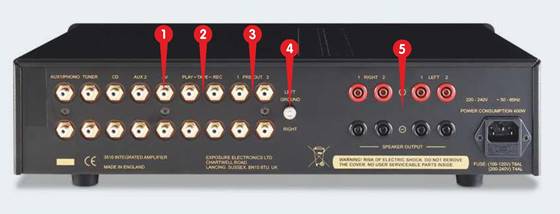
1) 5x RCA line-level inputs (one available for optional phono input)
2) Tape monitor loop on RCAs
3) Preamplifier outputs on RCAs
4) Grounding post
5) Bi-wireable speaker outputs on banana plug sockets
encourage growth over the years, as its doubled-up pre-out and speaker outputs suggest, while a detachable mains cable also begs for experimentation. These, too, recall the mind-set, Zeitgeist and status quo of the early days of Exposure, when cables, bi-wiring and other tweaks were hot topics and even audiophiles on a tight budget expected an element of flexibility. Hell, even the market-dominating, NAD 3020 offered a preamp output.
Sound quality
Switch-on is accompanied by a brief muted period, after which three red LEDs illuminate and inform us the system is operational: one for power on, one for the source indication and the last is on the motorised volume control so you can see its status from your listening position. When you hit mute, the source and level LEDs are extinguished. As for the headphone output, this mutes the speakers when you insert a 6.35mm jack, and during testing we struggle to find a pair of cans it won’t drive with anything less than complete distinction.
Of late, we’ve been rediscovering SACD, enamoured of the way that it narrows the gap between CD and LP and somewhat baffled by its cult status. What Exposure’s 3510 delivers with the impact you’d expect of a £ high-end import weighing 50kg is Harry Nilsson’s Nilsson Schmilsson.
Of course, the aching ballad Without You demands plenty of finesse, which the 3510 exhibits by the bushel, but it is the bass run that opens Jump Into The Fire that highlights this isn’t just another run-of-the-mill integrated.
For this track the bass guitar is the lead instrument with Herbie Flowers in virtuoso mode, dominating the number while the rest of the album is piano-biased. The 3510 reaches down deep, but it pulls off a rather deft trick: instead of the bass overshadowing all else, the guitars at the extreme ends of the soundstage hover around it, while Nilsson’s slightly nasal vocals nestle on top of that big, fat, bottom end.
All the while, there is a sense of coherence and openness more reminiscent of the vinyl offering than CD, while the drum solo towards the track’s finale has the kind of atmosphere expected of a pristine Kodo recording. Then the bass re-enters and even our diminutive LS3/5A seems more comfortable with the surfeit of lower octave material than one might imagine. The reason for this is simple – the 3510 exhibits speaker control like a sergeant major on a power trip.
As for Without You, written by Pete Ham and Tom Evans of Badfinger,
Installation is self- explanatory for anyone who’s ever set up a basic system
Nilsson treats it with a tenderness that recalls the great romantics such as Johnny Mathis, the stage set with the most delicate piano trills, along with the combination of utterly gorgeous strings and horns.
EARLY EXPOSURE
Founded in 1974 by John Farlowe, Exposure set out to make: “real world hi-fi at real world prices”, shoehorning audiophile circuit design into basic but sturdy matt-black casework. In practice, the fledgling brand took flight with the Exposure I loudspeaker, followed by the II shortly after. The first amplifiers were a solidstate pre/power combination dubbed the III and IV that went head to head with competing black boxes from that other estimable Brit brand of the same era, Naim Audio, in Salisbury.
By the mid-Eighties, the X integrated amp had proved itself popular, followed much later by the XV, XX and XXV derivatives. The digital revolution had rather passed Exposure by for the first 15 years
until it finally launched its first CD player in 1999. Subsequently there was a veritable flurry of silver-disc spinners including the 2010 CD in 2002 and premium XXII CD player in 2003. Early products were designed by Farlowe, and later by his successor Tony Brady who has held the chair from 2000 to the present day.
Tony masterminded the 2010 series and, very soon after, the long-running 3010 series, only now superseded by the new 3510 amplifier featured before you. Finally, although still describing itself as: “a British company”, with its design and manufacturing base remaining in Lancing, West Sussex, Exposure Electronics Ltd. has actually been in Malaysian ownership for the last 20 years.
IN SIGHT
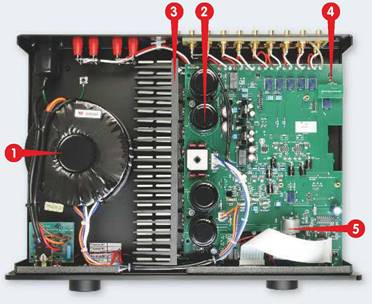
1) Substantial toroidal mains transformer feeds…
2) … beefy regulated main power supply
3) Two pairs of Toshiba power transistors per channel, bolted onto large internal heatsink
4) Optional phono module fits here
5) Motorised rotary volume control
What the 3510 does is present them with a silkiness more commonly associated with tubes like EL34s or even 300Bs. The 3510 is swiftly emerging as a solid-state amp for those who want but cannot cope with the responsibility of valves. Better still is the sense of majesty that this love song warrants, because, let’s face it, it is one of the all-time heartbreakers, up there with the likes of The Beatles’ In My Life and The Kinks’ Waterloo Sunset.
As we’re starting to come to the conclusion that – at least in digital terms – using SACD is a bit of a cheat because it’s so inherently superior to any other pre-recorded digital format, we decide to instead turn to plain old CD, and slip in a disc from Now Yearbook 1983 and settle in for a suitably Eighties burst of Toto’s Africa.
The thinking behind this selection is to ascertain whether, like any really superior system, the Exposure 3510 will render anything, no matter what its instrumentation, production or genre, palatable – listenable even.
Africa is typically ‘from the Eighties’ with all the shallow studio values that the period is renowned for. It was a synthesiser-driven era, reeking of artifice so bright and edgy that one’s teeth ached, so if the Exposure can do something halfway decent with Toto, then it really is a champion.
Actually, that’s a mite unfair on Toto. They were peerless musicians and Africa is passably elegiac. So on it goes and straight away we’re hearing snap and transient attack, supported by rich bass. It’s terribly hard to unravel precisely what instruments are actually played on this track because it is, like most of the other stuff that came from 1983, a mix of the ‘real’ and the electronic.
Regardless, the sound draws us in, a scaled-down facsimile of what is possible from an SACD via £’s worth of high-end kit. And it’s certainly enough to sell us on the 3510’s sheer listenability, its competence having already been demonstrated with the Nilsson SACD.
Another track on the Now Yearbook 1983 compilation is worth putting through its paces, the surprise a cappella hit, Only You courtesy of The Flying Pickets. Five voices in perfect harmony: the challenge here is to see how Exposure’s 3510 separates them, even though we have no clue whether this recording was multi-tracked and tweaked in the studio or otherwise manipulated electronically. Whatever the actuality behind its origins, the Exposure opens up the performance brilliantly, more than sufficient for the listener to home in on each voice with remarkable facility, and yet the whole is always highly cohesive.
This integrated amplifier looks as if it has escaped from the mid-Eighties
It’s Mobile Fidelity’s new 45rpm issue of Jeff Beck’s immortal Truth LP, first released in 1968 on EMI that really stamps a solid Recommended on this integrated amp. The 3510 handles every element with skill, from the textures of a then-young Rod ‘The Mod’ Stewart’s rasping vocals to the rolling bass courtesy of sometime Face and now Rolling Stone Ronnie Wood, all the while respecting the thunderous percussion of the vastly underrated Micky Waller. The album was produced by Mickie Most at the height of his powers and is regarded – quite rightly – as the moment that the blues made the transition into heavy rock.
The star here, of course, is Beck himself, who partnered Jimmy Page in The Yardbirds apart from doing his solo thing. His speciality is pretty much everything, wrenching myriad textures and sounds from his guitars: wah-wah, fuzz, Indian-influenced psychedelia, even a lush interpretation of Greensleeves.
Conclusion
So, apart from whole heartily recommending this Exposure integrated, here’s a tip for any dealer keen to demo the 3510 for prospective buyers. Treat them with a blast of Jeff Beck’s Truth and chances are you’ll sell one every time
OUR VERDICT
OVERALL
